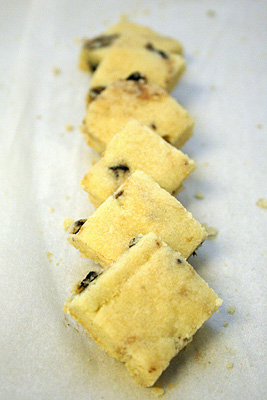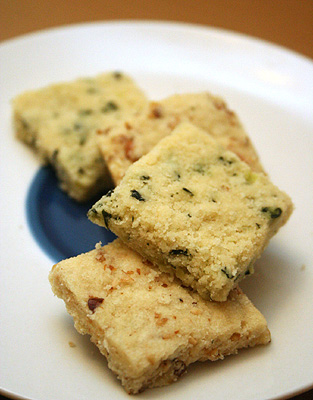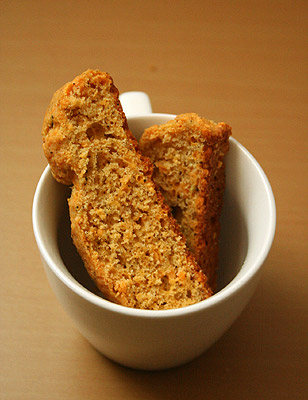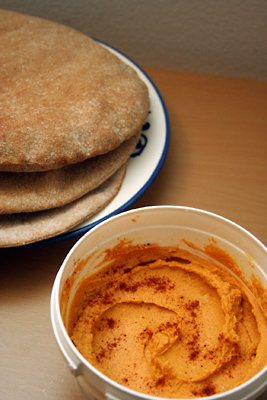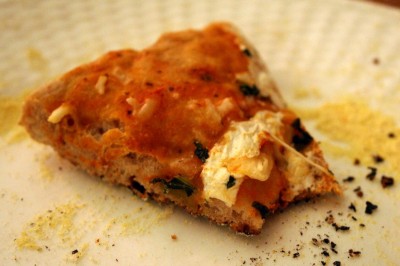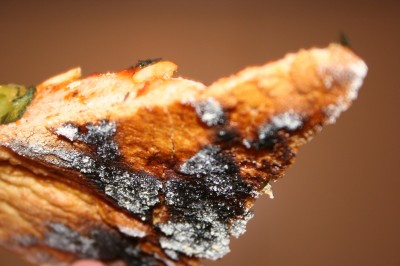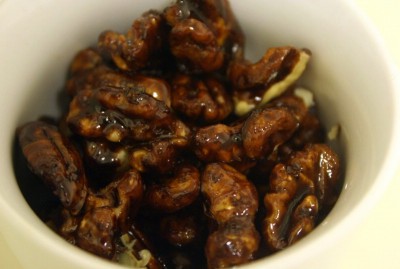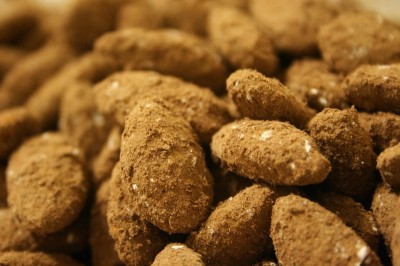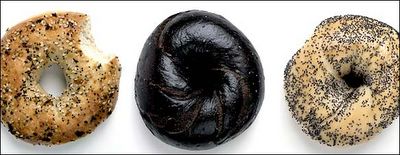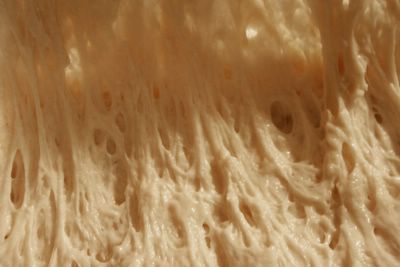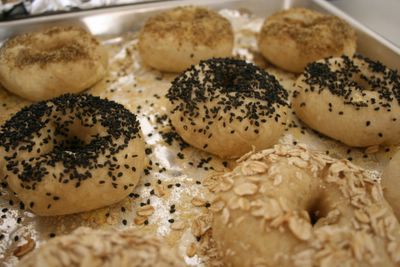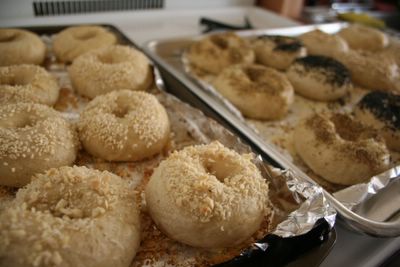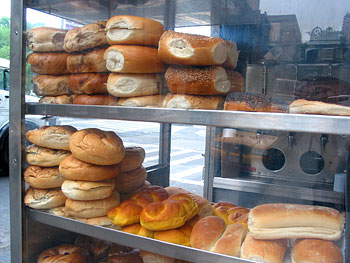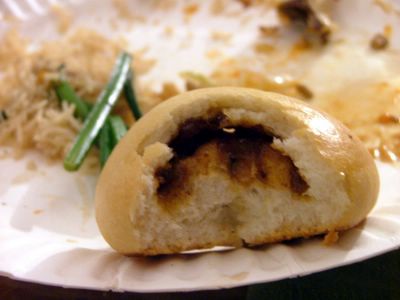
On Sunday, my apartment threw a dinner party not for the Superbowl (bah, what’s that?) but for Chinese New Year. I decided to go all out and make roast pork buns (char siu bao) completely from scratch. The buns come in two styles: fluffy, white steamed dough or eggy baked bread. I baked mine because I don’t have a giant steamer.
Of course, the star ingredient of the buns is roast pork. You may buy the cooked meat from a Chinese restaurant or make your own.
Roast Pork (Char Siu)
from The Key to Chinese Cooking by Irene Kuo
Cantonese barbecue meat is characterized by its deep red color, sweet flavor, and charred edges. Thinly sliced pieces are perfect as a stand-alone appetizer. The meat can also be added to fried rice, lo mein (ribbon-like rice noodles), Singapore (curry) noodles, and roast pork buns. A common error is to add salt to the marinade, which toughens the meat. You can substitute ketchup for the traditional red dye. It thickens the marinade for better coating.
Maltose (the same sugary goo that coats Peking Duck to crisp its skin) is traditionally used in the marinade, but honey can be substituted.

While honey has floral or fruity undertones (depending on what kind of pollen the bees hang around), maltose has a more neutral flavor. Maltose is also so thick that you can grab a chunk with your bare hands. But when you try to separate it, cobweb-like strands form at the edges, kind of like the cheese on pizza, but worse.
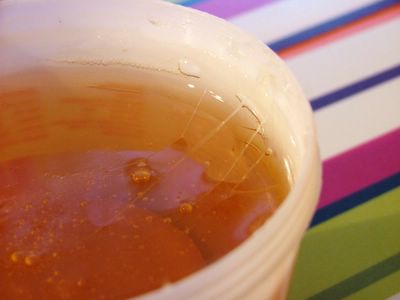
Ingredients:
Meat:
2 pounds boneless pork loin
Marinade:
3 tbsp light soy sauce
2 tbsp bean paste
1 tbsp Shao Xing rice wine or dry sherry
2 tbsp ketchup
2 tbsp pineapple or orange juice
1 tbsp sugar
1 tbsp maltose (also sold as malt extract I believe), honey, or corn syrup
2 cloves garlic, curhsed, peeled and coarsely chopped
1/2 tsp five-spice powder (a mixture of ground star anise, fennel, cloves, cinnamon and ginger)
Trim the meat of excess fat. I used rib loin to save money. When I deboned and de-fatted the meat, I only had half of what I started with.
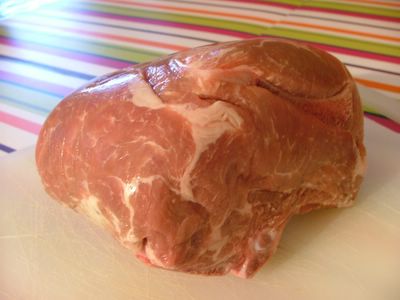
Slice it lengthwise, with the grain, into strips about 2 inches wide, 1 inch thick, and 5 to 6 inches long. Note to self: the grain runs in the same direction as the fat. Place them flat in a shallow pan. Stir the marinade ingredients in a bowl until well blended (if using maltose, heat the marinade over low heat to dissolve it) and pour over the meat, rubbing it well into both sides. Cover and marinate for about 3 hours at room temperature, turning the meat a couple times. You could also refrigerate the meat and bring it to room temperature before roasting, but it shouldn’t be marinated longer than 6 hours — prolonged soaking damages the firm texture.
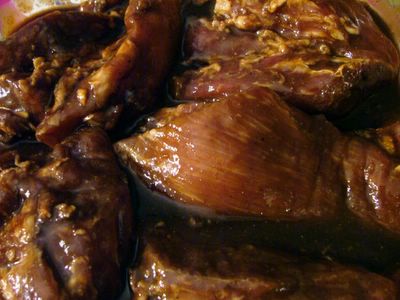
My strips were too small because I couldn’t tell which way the grain ran and cut with it.
Remove all the racks from your oven but the topmost one. Pour a few inches of water into a roasting or broiling water and place it on the floor of the oven to catch drippings and prevent smoking. Preheat the oven to 350 degrees.
Insert a meat hook, drapery hook, or even a bent strong paper clip into one end of each strip (1 hook per strip) and hook the strips onto the top rack over the drip pan in one line.
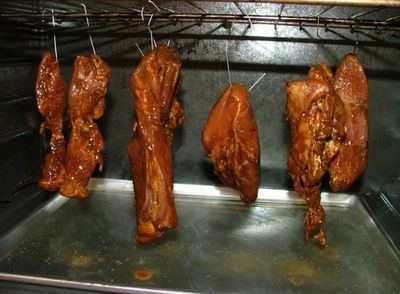
Hanging meat, ghetto Chinatown style.
Roast the strips for 1 hour. Then increase heat to 400 degrees and roast for 10 more minutes.
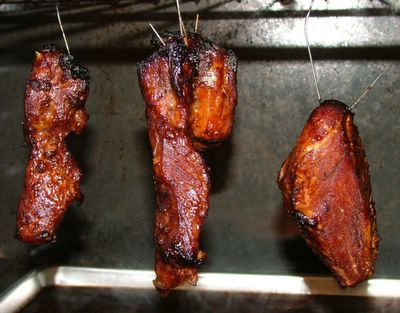
Remove meat and take out the hooks.

The “char” of char siu. Aka instant cancer, but it sure tastes good!
Let the strips cool and firm slightly and then slice them crosswise, against the grain. The pork is good hot, at room temperature, or cold.
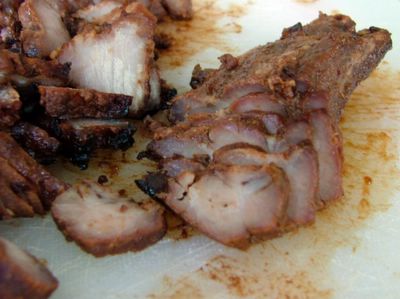
To reheat cold or frozen pork, place slices in an overlapping line in a snug shallow ovenproof dish. Pour a little meat stock over the meat (about 1/8 inch) and heat in a moderate oven or under a slow broiler until the liquid is steaming, the meat is hot inside, and the top surface is crisp. If you have no stock, you could season some water with soy sauce and honey or syrup to taste.
Don’t throw away the leftover marinade either! Just boil it on the stove for a couple minutes and save the liquid gold as a topping over rice or noodles. Thanks to Renee of Shiokadelicious for the tip!
Once again, The Key to Chinese Cooking came through for me. The book is like the Chinese version of The Joy of Cooking: reliable and thorough. I really liked the method of hanging the meat over water. No turning or basting was required, since heat evenly circulated the meat, and the water kept the meat moist. Roast pork is easy to make, and it’s okay (favorable, actually) to overcook it slightly so you get the crispy charred bits.
I thought the meat tasted more like Korean barbecue than Chinese roast pork, but it was delicious! Next time I’ll put a little less bean paste and more maltose. I’m not a meat person, but I could eat this roast pork on a stick.
Baked Pork Buns (Char Siu Bao)
adapted from The Chinese Kitchen (not as thorough as The Key to Chinese Cooking, but its strong suit is its dim sum recipes) by Eileen Yin-Fei Lo
For the Filling (make while the dough is rising):
5 tablespoons low-sodium chicken stock skimmed of fat (I used my roast pork drippings, skimmed)
1 tbsp oyster sauce
2 1/2 tsp sugar
2 1/4 tsp tapioca or corn starch
2 tsp ketchup
1 1/2 tsp dark soy sauce
Pinch ground white pepper
1 tbsp oil
1 small onion, cut into 1/4-inch pieces
3/4 cup barbecued pork, cut into 1/2-inch pieces
1 1/2 tsp Shao Xing rice wine or gin
1 tsp toasted sesame oil
In a small bowl, combine chicken stock, oyster sauce, sugar, tapioca starch, ketchup, soy sauce, and white pepper; set aside.
Heat a wok over high heat for 40 seconds and add oil. Coat wok with oil using a spatula. When a wisp of white smoke appears, add onion. Lower heat to medium, and cook until onion turns light brown, about 2 minutes. Raise heat to high, add pork, and cook, stirring, for 2 minutes. Add wine, and stir to combine.
Stir the reserved stock mixture and add it to the wok. Cook, stirring, until the sauce thickens and turns brown, 1 to 1 1/2 minutes. Add sesame oil, and stir to combine. Transfer to a shallow dish. Cool to room temperature.
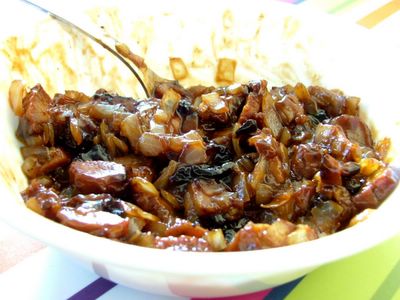
For the dough:
One 1/4-ounce envelope active dry yeast
1/3 cup sugar
1/2 cup warm water (110 F)
2 cups bread flour
1 large egg, beaten
3 tbsp lard or oil
1/2 tsp salt
1 1/2 tbsp scallion-infused oil or plain oil (optional)
In a large mixing bowl, dissolve the yeast and sugar in the hot water. Put in a warm place for 30 minutes to 1 hour, depending on the outside temperature. (In cooler weather, the longer time will be required.) When the yeast rises and brownish foam appears on top, add the flour, salt, oil and half the egg, stirring constantly with your hand.
Begin kneading. When the mixture becomes cohesive, sprinkle the work surface with flour and place the dough on it. Continue kneading for about 15 minutes, picking up the dough with a scraper and flouring the work surface to prevent sticking. When smooth and elastic, place the dough in a large bowl. Cover with a damp cloth or plastic wrap and put in a warm place for 2 to 4 hours, depending on the temperature. The dough is ready when it has tripled in size.
Heat the oven to 350F. Cut parchment paper into 12 pieces, 3 1/2 inches square. Or, grease a large piece of foil. Remove the dough from the bowl, knead several times, then roll out into a cylinder 12 inches long. Divide into 1-inch pieces.
Work with one piece at a time, keeping the others covered with a damp cloth. Roll each piece into a ball. (I used a trick I learned at my cousin’s bakery. I cupped my hand and rolled the ball between my palm and the work surface. I moved my hand very quickly to make the surface taught. The dough was ready when it bounced back after I stuck my finger in it. If you can leave an indentation in the dough ball, the surface isn’t tight enough.)
Press with your fingers to create a well in the ball. Place 1 1/2 tbsp of the filling into the well, hold a bun in one hand, and with the other turn the bun, pinching it closed. Press firmly to seal. Place the bun, seam side down, on the parchment paper or foil. Repeat until all 12 are done.
Place the buns on a cookie sheet, at least 2 inches apart to allow for expansion. Place the buns in a warm place to rise for 1 hour. Spritz each bun lightly with warm water. Make an egg wash by taking the remaining beaten egg and combining it with an equal amount of water. Brush each bun with the egg mixture.
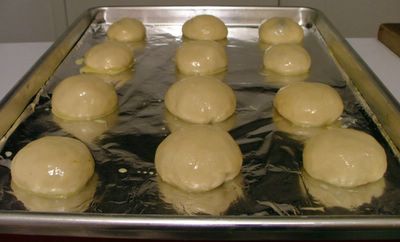
Bake for 15 to 20 minutes, or until golden brown. Halfway through the baking time, turn the cookie sheet around.
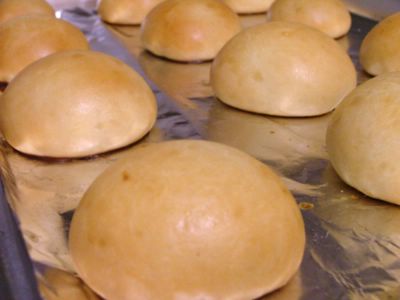
As the buns cool, their crusts will become slightly hard. If you want them to remain soft, brush lightly with oil immediately after baking.
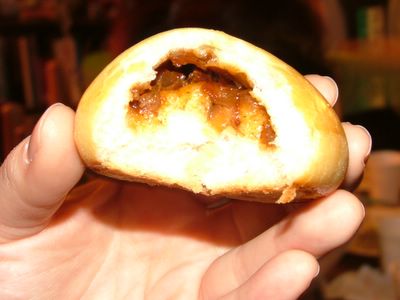
These were really good straight out of the oven, with the filling piping hot and the dough still soft. The filling was perfect. It was just the right mixture of sweet and savory. It was also thick but not unnaturally jelly-like. The dough was rich and slightly sweet, just like the kind you get in Chinatown. However, my dough wasn’t as airy because I was in a rush and only let it rise till double its size (not triple, like the recipe stated). Also, the recipe didn’t call for any salt in the dough. A touch of salt is always needed to bring out the flavor of baked goods.
I probably won’t make these from scratch again because it’s labor intensive, but I’m proud of my creation.



